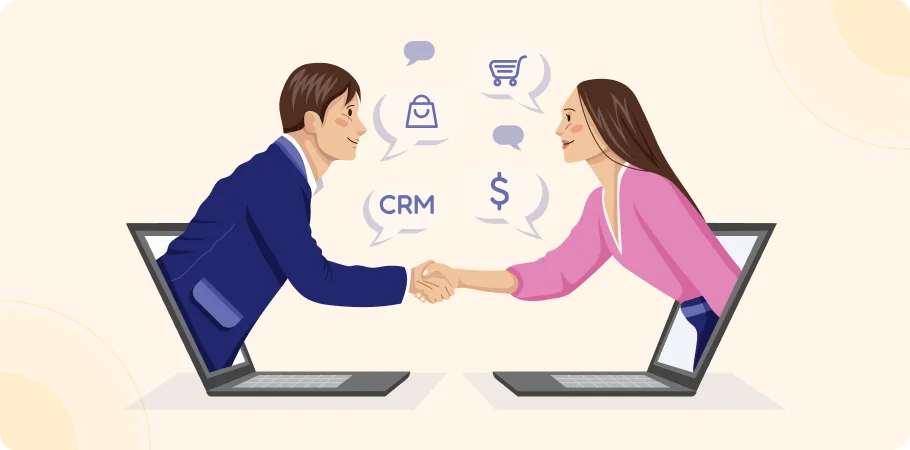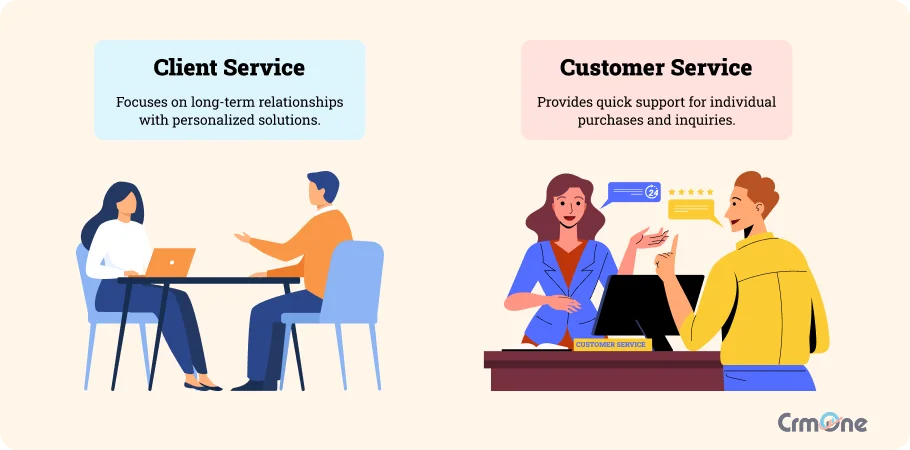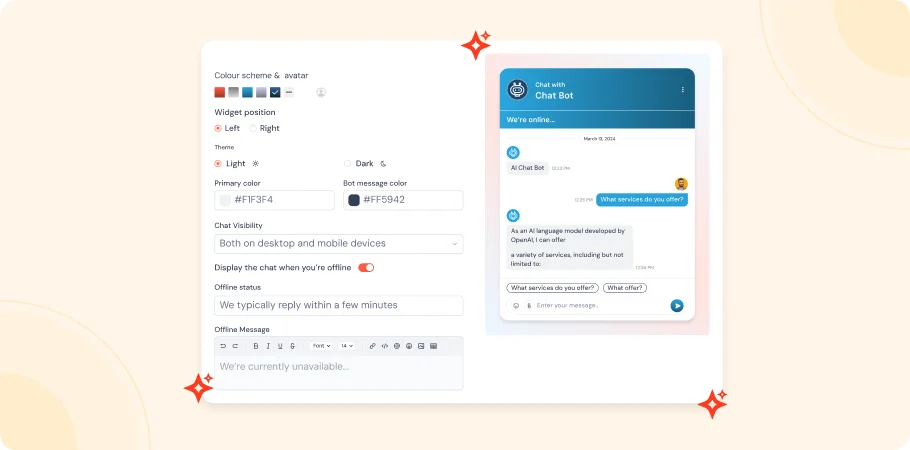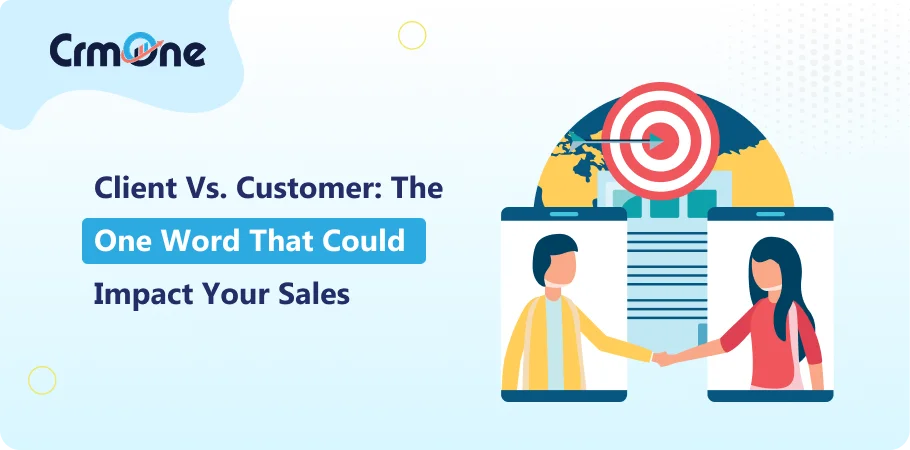We all know the power our words hold. In business terms words are play a crucial role in every segment, especially in building customer relationships. Talk about Sales, when you don’t just need a good script but also ability of formation of words to move the ‘sales call’ further. Not just in sales, but in marketing, communication and every segment, words define everything.
In business world, knowing when to use among the client vs customer becomes only necessary. The term ‘client’ and ‘customer’ are used interchangeably, but they represent distinct types of relationships with different needs and expectations. This leads to a common question: what is the difference between client and customer?
You have to understand the difference between these two so you can strategize accordingly for business success. You can also choose better tools like using a CRM for customer support to keep track of conversations, solving problems and give people a better experience.
Let’s start:
What is the Difference Between Client and Customer?

What is a Client?
Client meaning in business is someone who forms a long-term relationship with business. They need specialized services or advice that are suitable for their specific needs.
This relationships are built on trust and involves ongoing communication and personalized attention, which are hallmarks of client based services .Examples: working with a lawyer, a financial advisor, or a graphic design agency.
What is a Customer?
A customers has a transactional relationship with a business. They buy standardized products or services without any long term commitment.
This relationship is more about exchanging money for goods or services. Examples: shopping at a grocery store, dining at a restaurant, or buying clothes from a retail store.
Key Differences between client and customer
The major differences are the engagement level, services we offer to them, loyalty and impact of business. From clients business can expect a long term benefits while customers may buy several times.
Remember: Every Client is a Customer, but not every Customer is a Client.
| Difference | Client | Customer |
|---|---|---|
| Relationship Type | Ongoing, long-term relationship | Transactional, often short-term |
| Service Type | Specialized, professional services | tandardized products or services |
| Engagement Level | High engagement, personalized interaction | Minimal interaction beyond purchase |
| Service Customization | Tailored solutions based on specific needs | Standardized offerings with minimal customization |
| Loyalty | Typically more loyal due to ongoing relationship | Varies in loyalty, often transaction-driven |
| Investment | Willing to invest more for personalized services | Focuses on immediate needs, may not invest as much |
| Communication | Regular, personalized communication | Limited communication, often automated |
| Trust and Commitment | Built on trust and mutual commitment | Transactional, less emphasis on long-term commitment |
| Business Impact | Generates significant revenue from fewer relationships | Represents a broader base with potentially lower revenue per transaction |
| Support Expectations | Expects continuous support and solutions | Seeks immediate support related to the purchase |
Clients receive customized services because you have every data of them. Your teams can strategize accordingly. Customers buy standardized products, they are not looking for long term relationships at the time of purchase.
Sometimes you have to treat customer as a client, because you see potential in them. When you use CRM tools, you have the details of customer, you know what they are looking for, what are their interests and then you can offer products that solve their problems.
Another key point is clients generate high revenue from fewer relationships, while customers represent a broader base with low revenue per transaction. This even defines loyalty. Clients are more loyal because they already trust your brand, while customers loyalty varies as per their interests.
Train your team to give immediate response to customers, because they expect it right away. Clients expect continuous support and you can ask for more time if you are not ready with the solutions they are expecting.
What is client service vs customer service?

Client Service
Simply put it refers to personalized support given to individuals or businesses that have an ongoing or contract relationship with a company.
A consulting firm uses targeted marketing campaigns to attract new clients by highlighting their expertise in strategic planning. They deliver personalized service by assigning dedicated account managers to each clients.
Note: A client might have an LTV of $100,000 or more over several years, while a customer might have an LTV of $1,000 to $5,000 depending on the product or service.
Key Characteristics:
Ongoing Relationship:
Usually clients engage with the company for extended period via subscriptions, contracts, or partnerships. For example, consulting firms or SaaS providers.
Tailored Solutions:
Every client’s specific needs are taken into consideration before providing them with solution. So that their goals or industry requirements are met.
Proactive Approach:
Teams are always looking for client needs and provide strategic advice to help them succeed. For example: account managers or client success teams.
Professional Services Focus:
It is common in Industries like law, finance, marketing agencies and B2B services, where the relationship is more consultative and strategic.
Customer Service
It refers to spontaneous support given to individuals who purchase products or services from a company, mostly one-off or transactional interactions.
An e-commerce platform focuses its marketing on product discounts and fast shipping. It optimizes service delivery by implementing AI-powered chatbots for quick customer support and ensuring timely order fulfilment.
Key Characteristics:
Transactional Relationship:
A brief interaction between the customers and company. There are usually no commitments at the starting. For example: Retail or e-commerce purchases.
Standardized Support:
It is a focused on resolving issues like product inquiries, returns, or technical problems, unlike tailored solutions.
Reactive Approach:
The resolution is quick. Customer service teams are active, because customers want quick solutions. This is why AI is being deployed in customer support in majority of the companies to give instant replies.
Product/Service Focus:
Commonly seen in industries like retail, hospitality, and B2C businesses where the focus is on delivering a positive experience during individual transactions.

Examples and Case Studies
Consulting Firm and Corporate Client
A management consulting firm works with a large corporation to improve its operations. This engagement involves:
- Multiple meetings to understand the client’s specific needs
- Tailored analysis and recommendations
- Ongoing support and adjustments over several months
- Regular check-ins to ensure alignment with the client’s goals
Financial Advisor and Individual Client
A financial advisor provides personalized investment advice to a high-net-worth individual:
- Initial in-depth assessment of the client’s financial situation and goals
- Development of a customized long-term investment strategy
- Regular portfolio reviews and adjustments
- Proactive communication about market changes and opportunities
Customer Examples:
Grocery Shopping
A person visits a local supermarket to buy groceries:
- Selects items from shelves
- Interacts briefly with cashier during checkout
- May ask for assistance in finding a products
- Transaction is complete once payment is made
Online Shopping
A customer purchases items from an e-commerce website:
- Browses products and adds them to cart
- Completes checkout process
- Receives order confirmation email
- May contact customer service for shipping updates or returns
These examples highlight the key differences:
Clients typically have ongoing, personalized relationships
Customers often engage in shorter, more transactional interactions.
Boost Your Business
Performance with CrmOne
Our experts will guide you through the most effective
ways to use CrmOne,
ensuring you fully leverage its
features for maximum impact on your business.
Strategic Implications
What we have learnt so far is difference between clients and customers. In this section we will look for significant implications for business, particularly in how they approach marketing strategies and service delivery.
Marketing Strategies
The utilization of CRM tools become resourceful here. Because existing clients are your long-term and recurring buyers of products/ services. So you have to give them ‘special’ attention.
You need to serve them with all the data you have so your efforts reflect personalization to clients or customers to enhance engagement and conversion rates.
If you are serving clients, your marketing should be focused on building long-term relationships and highlight the value of personalized services. If you are serving customers, your marketing should focus on product features, promotions and quick transactions.
Delivering the Service
Its prominent to meet the unique needs of both clients and customers. For clients, this involves offering tailored services, regular check-ins for alignment with their goals, etc.
For customers, service delivery should focus on quick issue resolutions, clear communication about product availability and efficient transaction processing.
Handling and Managing Clients and Customers with CrmOne:
Managing Clients with CrmOne
To handle clients, you need to have a team that is experienced and know the ifs and buts. With CrmOne, you don’t need a specialized team to focus on this part, because its AI and Automation take care of almost everything.

The main focus while maintain client relationship is to take follow-ups and know where exactly are the clients at in terms of progress stages. So with visual sales pipeline features you can track client interactions, from initial consultations to ongoing support. The data sourcing will create a client profile so you can give personalized attention.
Leave those manual tasks already! How much of resources and time do we have to give it to the routine tasks. The automation will ensure consistent communication with clients.
Want to manage international clients but don’t know their language? CrmOne supports multiple language that makes it easier to manage them by communication in their preferred language. This sparks global reach.
When it comes to track income, costs and profits for individual client projects, CrmOne is marvellous. It helps in optimizing resource allocation and make sure that the clients are profitable.
Managing Customers with CrmOne
Instant support, else lose the customer! That’s what business means. So Put a Stop in such scenarios. The AI feature ‘Aeri’ is so powerful that it can resemble human voice, talk in the humanized tone and give response to customers instantly.

You can organize the customer information in one place with the contact management feature, this makes it easier for the team to have their hands on the customer information anytime.
The forecasting tools help you predict the customer purchasing patterns and optimize sales strategies accordingly. The powerful integration with third party apps lets data synchronization be smooth and puts all the platforms communication in a unified view.

Analyze customer behvaior and make informed decisions by using the reporting and analytics feature.
Conclusion:
Customer vs Consumer is another debatable question. But the only difference is the consumer is the end part of the process that actually consumes the product and customer may or may not be the end part of the process.
Similarly, many people often ask—what is the difference between client and customer? Though both are buyers but the thing is client usually receives ongoing services while customer often makes only one-time purchases.
Your approach towards clients and customers should be strategic. You need to have tools to identify potential ones. Ask your team to prepare a ‘sales plan’ accordingly. Though your clients are already purchasing from you, that doesn’t mean they should be taken as granted. Rather efforts should be made to smooth down their journey and fix the future problems even before they arise.
Get started for Free
Start for free today. Boost your sales by clicking the Get Started button. With CrmOne, you can manage leads, sales, and customer service all in one place.

